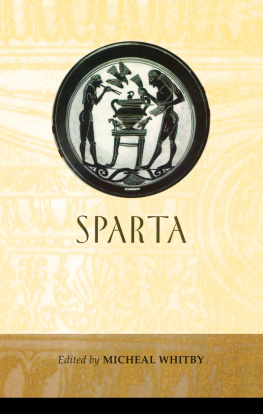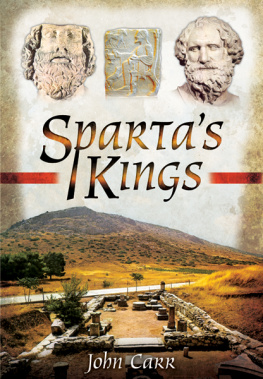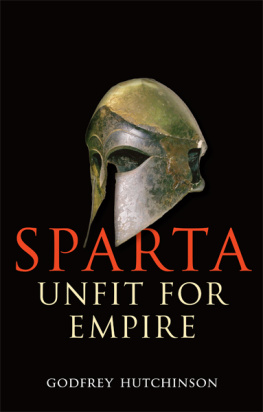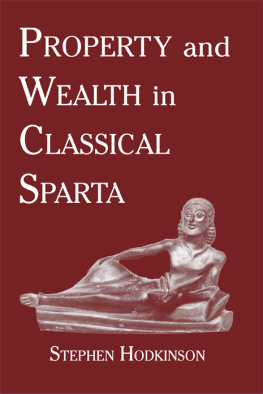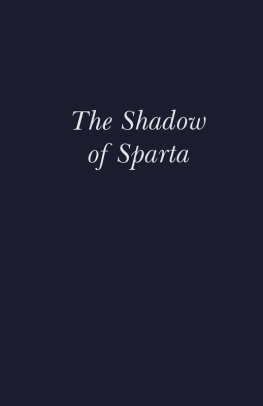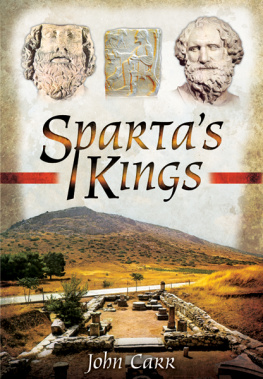Paul A. Rahe - Spartas Second Attic War: The Grand Strategy of Classical Sparta, 446-418 B.C.
Here you can read online Paul A. Rahe - Spartas Second Attic War: The Grand Strategy of Classical Sparta, 446-418 B.C. full text of the book (entire story) in english for free. Download pdf and epub, get meaning, cover and reviews about this ebook. year: 2020, publisher: Yale University Press, genre: Romance novel. Description of the work, (preface) as well as reviews are available. Best literature library LitArk.com created for fans of good reading and offers a wide selection of genres:
Romance novel
Science fiction
Adventure
Detective
Science
History
Home and family
Prose
Art
Politics
Computer
Non-fiction
Religion
Business
Children
Humor
Choose a favorite category and find really read worthwhile books. Enjoy immersion in the world of imagination, feel the emotions of the characters or learn something new for yourself, make an fascinating discovery.

- Book:Spartas Second Attic War: The Grand Strategy of Classical Sparta, 446-418 B.C.
- Author:
- Publisher:Yale University Press
- Genre:
- Year:2020
- Rating:4 / 5
- Favourites:Add to favourites
- Your mark:
- 80
- 1
- 2
- 3
- 4
- 5
Spartas Second Attic War: The Grand Strategy of Classical Sparta, 446-418 B.C.: summary, description and annotation
We offer to read an annotation, description, summary or preface (depends on what the author of the book "Spartas Second Attic War: The Grand Strategy of Classical Sparta, 446-418 B.C." wrote himself). If you haven't found the necessary information about the book — write in the comments, we will try to find it.
Paul A. Rahe: author's other books
Who wrote Spartas Second Attic War: The Grand Strategy of Classical Sparta, 446-418 B.C.? Find out the surname, the name of the author of the book and a list of all author's works by series.
Spartas Second Attic War: The Grand Strategy of Classical Sparta, 446-418 B.C. — read online for free the complete book (whole text) full work
Below is the text of the book, divided by pages. System saving the place of the last page read, allows you to conveniently read the book "Spartas Second Attic War: The Grand Strategy of Classical Sparta, 446-418 B.C." online for free, without having to search again every time where you left off. Put a bookmark, and you can go to the page where you finished reading at any time.
Font size:
Interval:
Bookmark:
T HE Y ALE L IBRARY OF M ILITARY H ISTORY
The Grand Strategy of Classical Sparta, 446418 B.C.
Paul A. Rahe

Published with assistance from the Kingsley Trust Association Publication Fund established by the Scroll and Key Society of Yale College.
Copyright 2020 by Paul A. Rahe.
All rights reserved.
This book may not be reproduced, in whole or in part, including illustrations, in any form (beyond that copying permitted by Sections 107 and 108 of the U.S. Copyright Law and except by reviewers for the public press), without written permission from the publishers.
Yale University Press books may be purchased in quantity for educational, business, or promotional use. For information, please e-mail (U.K. office).
Maps by Bill Nelson.
Set in Minion Roman and Trajan Pro types by Integrated Publishing Solutions.
Printed in the United States of America.
Library of Congress Control Number: 2019953866
ISBN 978-0-300-24262-1 (hardcover : alk. paper)
A catalogue record for this book is available from the British Library.
This paper meets the requirements of ANSI/NISO Z39.48-1992 (Permanence of Paper).
10 9 8 7 6 5 4 3 2 1
Antonia M. Rahe
Treaties are like young girls and roses; they last as long as they last.
CHARLES DE GAULLE
An Enduring Strategic Rivalry
I T is much easier to initiate a war than to end one. Even when an attempt to do the latter seems, to the unsuspecting glance, to be an unqualified success, it frequently lays the foundations for a renewal of conflict. The origins of the Second Punic War, of the War of the Spanish Succession, and of the Second World War can be found in the armistices and treaties of peace that ended the First Punic War, the War of the League of Augsburg, and the First World War.
In analyzing the first of these examples, the Greek historian Polybius articulated a principle that applies with equal force to all three. Statesmen, he warned,
must take heed lest the aims of those breaking off hostilities... escape their notice. Above all else, they must ascertain whether those coming to terms have yielded to circumstances or are broken in spirit. In this fashion, they can be constantly on guard against the former, who are apt to be lying in wait for a favorable opportunity, and they may trust in the latter as subjects and true friends and readily call upon them for whatever services occasions demand.
As Polybius implies, if the conditions that initially gave rise to a strategic rivalry persist, that rivalry is almost certain to revive, and a renewal of war may well be the consequence.
Spartas second Attic war allows us to test Polybius claim. The peace treaty that brought her first Attic war to an end settled nothing. That contest had had its roots in the fear inspired at Lacedaemon by the dramatic growth in Athenian power, and the treaty did nothing to reduce that power, prevent its further growth, assuage Lacedaemons fears, or alter the strategic assessment that had induced the Spartans to contemplate and plan an attack and the Athenians to anticipate such an assault and launch a preventive war.
Of course, had the war in question come to a conclusion with the decisive defeat of either hegemonic power and with its elimination as a threat, there would not have been a second Attic war. But, in 446 B.C., it ended, instead, with an attempt at restoring something like the status quo anteback before the antagonism first developed when the two powers had operated more or less amicably within different spheres. In consequence, though Athens had lost the war, she was not broken in spirit; and she did not suffer a great diminution in power.
By the same token, had Persias Great King Artaxerxes staged a massive invasion of Hellas at this time on the model of the invasion mounted by his father Xerxes in 481, the two main Greek powers might well have worked again in tandem, and the peace between them would almost certainly have enduredat least for a time. But three years before, in 449, the King of Kings had accepted the terms that the Athenians had once dictated to his father; and, to all appearances, Persia had withdrawn from the scene, leaving that empires former antagonists warily eyeing one another.
In the circumstances, there was much for statesmen, would-be statesmen, and ordinary citizens to ponder. Was the struggle with Persia genuinely over? Was the contest setting Sparta and her allies against Athens and hers really finished? Or were the two agreements bringing combat to an endthe Peace of Callias and the Thirty Years Peaceno more than truces? Could there ever be a lasting settlement with Persia? Could trust and goodwill be reestablished between the two principal Greek powers? Or, in the absence of a common threat, was there no foundation for their cooperation? And if this was the case, was Spartas victory in 446 a freak accident or an indication of her enduring strategic superiority?
These were the questions asked at the time, and there were morefor Athens was supreme at sea and Sparta on land, and it was exceedingly difficult, if not impossible, for either city to project power on the element dominated by the other. In time, everyone wondered, were war to break out again, which of the two would have the greater leverage? In extremis, would the weaker party look to Achaemenid Persia for aid? And would the Great King intervene?
There were a great many other questions asked as well. For each of the cities within the two coalitions had her own history and her own peculiar concerns; and the same can be said for the communities which had been neutral during Spartas first Attic war. Moreover, most of the Greeks who lived in these divers cities and were possessed of a voice in the public assemblies that governed these tiny republics were extremely narrow in their outlook; and, within their particular ples, they were a quarrelsome lot. In the best of circumstances, they were inclined to calculate solely with regard to their own communitys parochial interests. In the worst of circumstances, they would turn on one another, and each of the factions that emerged would be tempted to seek support abroad.
In The Spartan Regime, which was intended to serve as a prelude to a series on the evolution of Lacedaemonian foreign policy, I analyzed the character of the Spartan polity, traced its origins, and described the grand strategy that the Lacedaemonians first articulated in the mid-sixth centurybefore the Persians burst on the scenefor the defense of that polity and the way of life associated with it. In the early chapters of the first volume in the seriesThe Grand Strategy of Classical Sparta: The Persian ChallengeI restated the conclusions reached in that prelude and explored in detail the manner in which the Spartans gradually adjusted that strategy to fit the new and unexpected challenge that suddenly loomed on the horizon when the Mede first appeared. Then, in the last four chapters of the work, I described the fashion in which they organized and managed the alliance with which they confronted and defeated the invader bearing down on Hellas.
In that volumes sequel, Spartas First Attic War, I traced the manner in which the victorious Hellenes gradually and awkwardly worked out a postwar settlement that seemed to suit all concerned, and I paid particular attention, as in its predecessor, to neglected aspects of the storyabove all, to the grand strategy pursued by the Lacedaemonians in this period, to the logic underpinning it, to the principal challenge to which it was exposed, and the adjustments that had to be made; but also to the noiseless revolution that took place at Athens in these years and to the implications of this change of regime for the rearticulation of Athens traditional grand strategy. Then, I considered the fragility of the postwar settlement; I traced its collapse and the manner in which Sparta and Athens came into conflict; and I described the war they fought and the peace they forged.
Next pageFont size:
Interval:
Bookmark:
Similar books «Spartas Second Attic War: The Grand Strategy of Classical Sparta, 446-418 B.C.»
Look at similar books to Spartas Second Attic War: The Grand Strategy of Classical Sparta, 446-418 B.C.. We have selected literature similar in name and meaning in the hope of providing readers with more options to find new, interesting, not yet read works.
Discussion, reviews of the book Spartas Second Attic War: The Grand Strategy of Classical Sparta, 446-418 B.C. and just readers' own opinions. Leave your comments, write what you think about the work, its meaning or the main characters. Specify what exactly you liked and what you didn't like, and why you think so.



